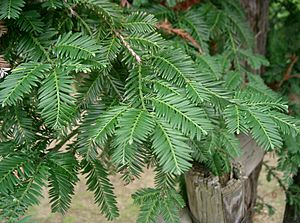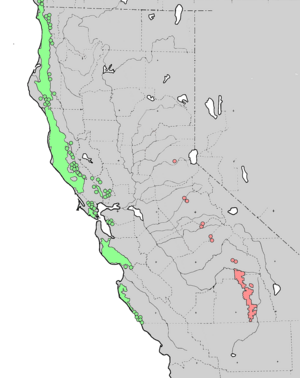Sequoia (genus) facts for kids
Quick facts for kids Sequoia (genus)Temporal range: Jurassic to present
|
|
|---|---|
 |
|
| Needles | |
| Scientific classification |
|
| Kingdom: | Plantae |
| Clade: | Tracheophytes |
| Division: | Pinophyta |
| Class: | Pinopsida |
| Order: | Pinales |
| Family: | Cupressaceae |
| Subfamily: | Sequoioideae |
| Genus: | Sequoia Endl., conserved name |
| Species | |
|
|
 |
|
| Natural ranges of Sequoia and Sequiodendron
green - Sequoia sempervirens
red - Sequoiadendron giganteum
|
|
| Synonyms | |
|
|
Sequoia is a genus of redwood coniferous trees in the subfamily Sequoioideae of the family Cupressaceae. The only extant species of the genus is Sequoia sempervirens in the Northern California coastal forests ecoregion of Northern California and Southwestern Oregon in the United States. The two other genera, Sequoiadendron and Metasequoia, in the subfamily Sequoioideae are closely related to Sequoia. It includes the tallest trees, as well as the heaviest, in the world.
Several extinct species have been named from fossils, including Sequoia affinis (Western North America), Sequoia chinensis (no valid reference, identification uncertain) of China, Sequoia langsdorfii (reclassified as Metasequoia), Sequoia dakotensis (reclassified as Metasequoia) of South Dakota (Maastrichtian), and Sequoia magnifica (petrified wood from the Yellowstone National Park area).
Etymology
The name Sequoia was first published as a genus name by the Austrian botanist Stephan Endlicher in 1847. However, he left no specific reasons for choosing that name, and there is no record of anyone else speaking to him about its origin.
The most common modern guess is that Endlicher, a published linguist, sinologist, philologist, as well as a systematic botanist, named the genus in honor of Sequoyah, the inventor of the Cherokee writing system, now known as Sequoyan. Beginning in the 1860s, it was suggested that the name is instead a derivation from the Latin word for "sequence", since the species was thought to be a follower or remnant of massive ancient, extinct species, and thus the next in a sequence.
However, in a 2012 article, author Gary Lowe argues that Endlicher would not have had the knowledge to conceive of Sequoia sempervirens as the successor to a fossil sequence, and that he more likely saw it, within the framework of his taxonomic arrangements, as completing a morphological sequence of species in regards to the number of seeds per cone scale.
In 2017, Dr. Nancy Muleady-Mecham of Northern Arizona University, after extensive research with original documents in Austria, claimed to find a positive link to the person Sequoyah and Endlicher as well as information that the use of the Latin sequor would not have been correct, however there are debilitating limitations to the arguments presented in the 2017 article. The alleged positive link is based on a similarity in pronunciation of the words “Sequoyah” and “Sequoia”; valid to persons that think in English, but not those that think in German or Latin. Endlicher could not have known how Sequoyah’s name was pronounced in Cherokee since he never had the opportunity to hear spoken Cherokee. The claimed use of Latin ignores Endlicher’s philological background and familiarity with the Latin of the ancient manuscripts in the royal library on which he extensively published. Endlicher’s Botanical Latin prefix in the genus name Sequoia was derived from the Latin verb “sequor”, and was not a conjugation of the verb.
Paleontology
Sequoia jeholensis is the oldest recorded member of the genus Sequoia (Along with Sequoia portlandica, but this last is a nomen dubium) , know from the Jiufotang Formation (Lower Cretaceous) and the Jiulongshan Formation (Middle Jurassic) of China. By the late Cretaceous the ancestral sequoias were established in Europe, parts of China, and western North America. Comparisons among fossils and modern organisms suggest that by this period Sequoia ancestors had already evolved a greater tracheid diameter that allowed it to reach the great heights characteristic of the modern Sequoia sempervirens (coast redwood) and Sequoiadendron giganteum (giant sequoia).
Sequoia ancestors were not dominant in the tropical high northern latitudes, like Metasequoia, a redwood whose deciduous habit gave it a significant adaptive advantage in an environment with 3 months of continuous darkness. However, there still was possibly prolonged range overlap between Sequoia and Metasequoia which could have led to hybridization events that created the modern hexaploid Sequoia sempervirens. See also the metastudy of the geologic history of the giant sequoia and the coast redwood.
A general cooling trend by the late Eocene and Oligocene reduced the northern ranges of ancestral Sequoia. By the end of the Miocene and beginning of the Pliocene, Sequoia fossils were morphologically identical to the modern Sequoia sempervirens. Continued cooling in the Pliocene meant that Sequoia, which is extremely intolerant to frost due to the high water content of its tissues, also became locally extinct in response to the extreme cooling of Europe and Asia In western North America it continued to move south through coastal Oregon and California, surviving due to the abundant rainfall and mild seasons. The Sierra Nevada orogeny further isolated Sequoia because the snowy mountain peaks prevented eastward expansion. The Pleistocene and Holocene distributions are likely nearly identical to the modern S. sempervirens distributions.


